“Se es mas feliz viviendo en una cabana dentro de un parque que en un palacio sin jardin.” [One is happier living in a cabin in a park than in a palace without a garden.]
– Carlos Thays, French landscape architect
Buenos Aires – Despite having designed some of Buenos Aires’ most important parks – the Bosque de Palermo, the Botanical Gardens, Barrancas del Belgrano, Parque Lezama, Parque Patricios, and the Plazas San Martín, de Mayo, Congreso, and Constitución, when it came time to have a park dedicated to Carlos Thays, the city chose a space between the bustling Avenida Libertador and the railroad tracks as its site. Like many of the parks here in town, this one has been left to the wiles of time – the center fountain is grown over with weeds and barely registers on peripheral vision, the children’s playground is filled with equipment that has seen far better days, the futbol pitch is evident only as a more trampled area of grass from the kids who walk over from the nearby shantytown to play on it, and the statuary has been left to erode in the wind and rain. It’s a park I’ve paid little attention to – often appearing to be populated by groups of teens playing soccer or hanging out, the occasional homeless person sleeping under the shade of a tree, and a few scattered joggers – in fact, I only found myself there because a friend of mine in Seattle is a major fan of Ástor Piazzolla, tango composer and accordionist, whom, my friend asserts, has never been accorded his due.
A quick online search revealed Ley 1132, a law passed on October 9, 2003, authorizing the placement of a monument to El Gran Ástor in “the green space across from the intersection of Avenidas Libertador and Callao – that’s where Parque Carlos Thays is. The law further empowered a commission to hold a design competition, and get the monument installed. I headed over to snap a photo or two of the sculpture for my friend. However, things move slowly here in Buenos Aires, and while I haven’t determined whether or not the design competition has been held or the status of the whole project, I can assert that I only found five sculptures in the park and none of them was of or to him. Still, they’re of interest…
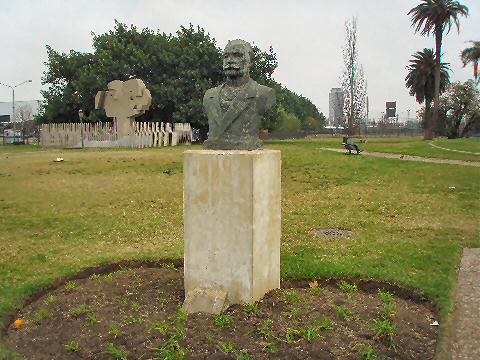
Starting at the far western end of the park is a bust of Carlos Thays. I only know it’s him because it’s identical to the bust in front of the gardening school in the Botanical Gardens. There’s no plaque – there’s a small concrete wedge at the bottom of the pedestal that may once have had lettering engraved or a plaque attached, but no more.
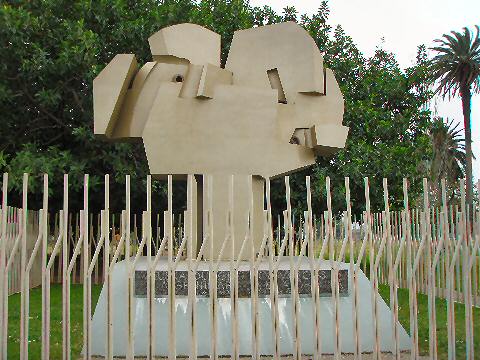
Over his right shoulder is one of those modern art-ish sort of sculptures that I loathe, this one fenced in presumably to provide it some modicum of protection from vandals. It’s entitled
The Tree, and is offered up as a sort of tribute to the Basque community in Argentina – a work of iron by Basque artist Néstor Basterretxea, whom, I gather, lives here in Buenos Aires and has won all sorts of prestigious awards for his work such as this abstract work clearly inspired by the PBS logo….
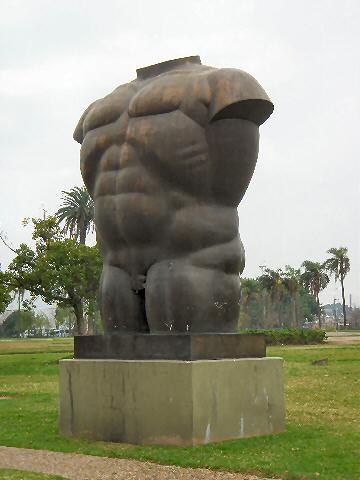
Probably the most recognizable sculpture in the park, easily seen from the street and regularly pointed out by tour guides as their mini-bus passes by, this is Fernando Bótero’s
Torso Masculino Desnudo (you can figure that out, right?). Bótero is a Colombian artist famed for his “over-proportioned” figures (many less than complimentary art critics apparently refer to them as “Bótero’s Fat People”) that grace various plazas and parks around the world.
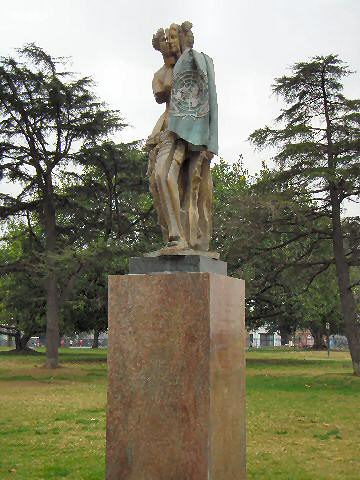
Local sculptor Marta Minujín is well-known here, and, I gather, throughout the contemporary art world for her statues with their sort of sliced heads, no doubt representing some sort of psychological condition that she sees within her work. This is part of her “Venus Fragmented” series and is entitled
Humanity and the United Nations. The pedestal is covered on all four sides with inscriptions, but they’re so worn that only a few words can still be made out clearly – it’d be interesting to know what it all says. And hmmm… another PBS logo inspired idea…
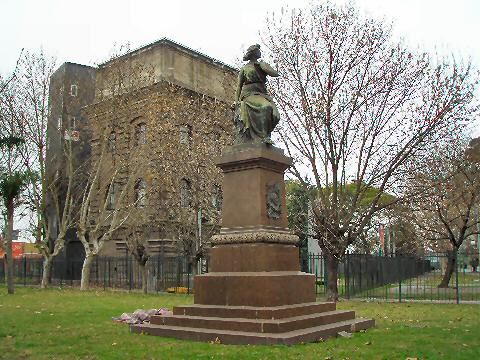
And finally, in the spot that I expected to find the Piazzolla monument right at Libertador and Callao, on the eastern edge of the park, this unattributed statue, inscribed at the base
Pro-Cultura Nacional and with an embossed plaque with two profiled faces and a rim inscription that says
Falcon – Lartigau – XIV – XI – MCMXIV. According to data in the city government’s online monument catalog, the work is by Italian sculptor Garibaldi Affani and was placed there on May 12, 1941. This monument is dedicated to Colonel Ramón Falcon and his 20-year old secretary Juan Lartigau, the former having been the chief of police in Buenos Aires in the early 1900s – the two of them were killed on November 14, 1909 (five years earlier than the date on the plaque) by a bomb thrown by a Russian anarchist in retaliation for the “May Day Massacre” that occurred during a socialist workers’ demonstration on May 1, 1909 when police killed a dozen of the demonstrators.










“Se es mas feliz viviendo en una cabana dentro de un parque que en un palacio sin jardin.”
Siempre lo creía, pero la oportunidad no se presentaba. Es el anhelo que juro que voy a realizar.
[…] To the right, in a small point of land, two statues, the first that of San Martin de Tours himself, patron saint of France, soldiers, and the city of Buenos Aires, in classic pose astride a horse with a beggar reaching towards him in supplication. At the top of the point, alongside famed cafe La Biela, is a statue to former police chief Ramón Falcon, whose story I covered in a post on Parque Carlos Thays… […]
[…] at one point, the Spanish Embassy was located to one side of the plaza. The park, designed by Carlos Thays, and clearly at one time quite beautiful, was designed as the “southern botanical […]
[…] a strange little building, standing alone in a field next to Carlos Thays Park. When I came up to the front door there was a young man inside mopping the floor, he came over and […]